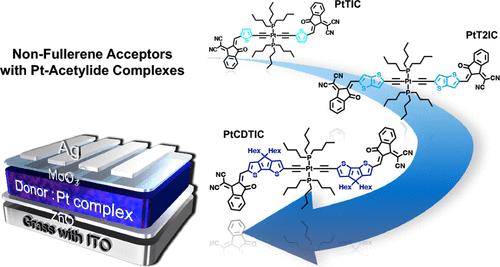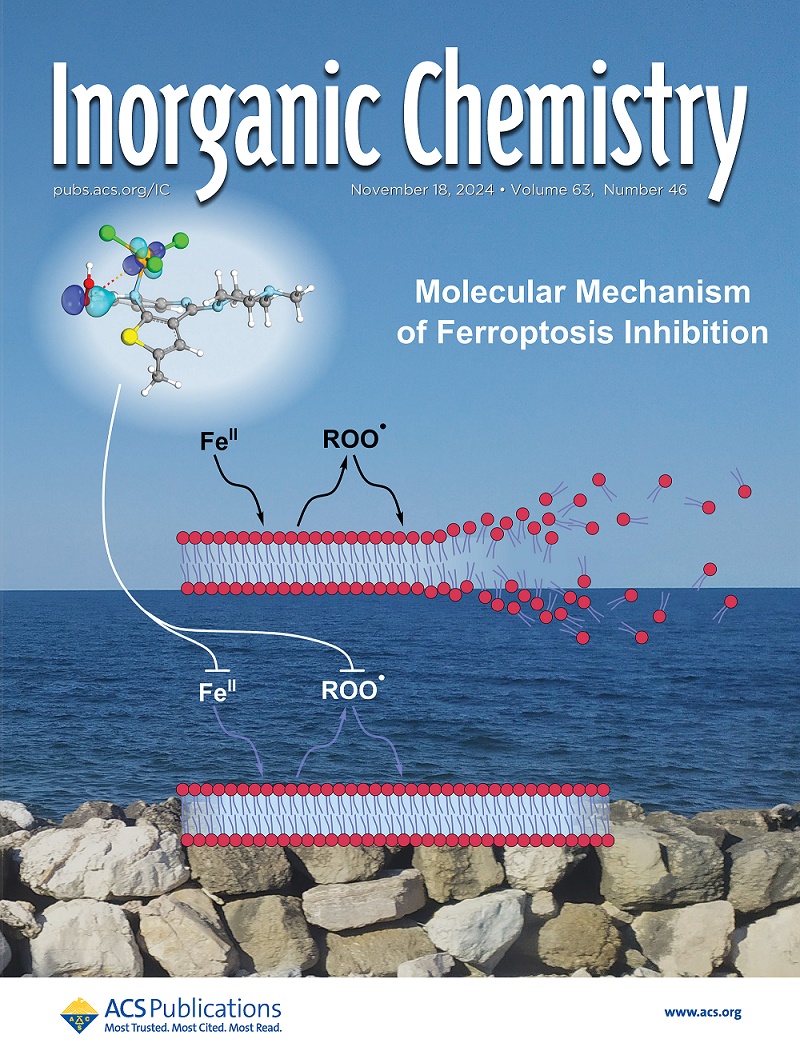铂-乙酰基配合物在有机光伏系统中的非富勒烯受体研究
IF 4.7
2区 化学
Q1 CHEMISTRY, INORGANIC & NUCLEAR
引用次数: 0
摘要
从铂-三烷基膦配合物中得到了三种不同的n型半导体;为了降低其LUMO水平,采用噻吩(PtTIC(1))、噻吩[3,2-b]噻吩(PtT2IC(2))和4h -环五[2,1-b:3,4-b ']二噻吩(PtCDTIC(3))作为乙酰基给体单位加入了各种吲哚衍生物。单晶x射线衍射分析显示,所有病例的铂-乙酰醚络合均呈直线移位。独立受体单位的氧原子和噻吩衍生的给体单位的硫原子之间的强(= O··S)相互作用诱导了杂环配体之间的高度平面取向,平面之间具有π -π相互作用。铂配合物1、2和3在500-800 nm范围内表现出很强的吸收,这是由于从中心含铂的给体单元到末端受体的有效的分子内电荷转移转变,以及由于重原子效应在近红外区域的独特发射。紫外光电子能谱结果表明,其LUMO水平与典型的非富勒烯受体相当。包含1、2和3 as nfa的n型半导体在相应的有机光伏中表现出光电转换特性。配合物3的转化效率最高,为3.0%。本文章由计算机程序翻译,如有差异,请以英文原文为准。

Platinum–Acetylide Complexes as Nonfullerene Acceptors in Organic Photovoltaic Systems
Three distinct n-type semiconductors were derived from a platinum-trialkyl phosphine complex; to lower their LUMO levels, various indene derivatives were incorporated using thiophene (PtTIC (1)), thieno[3,2-b]thiophene (PtT2IC (2)), and 4H-cyclopenta[2,1-b:3,4-b′]dithiophene (PtCDTIC (3)) as the acetylide donor units. Single-crystal X-ray diffractometry analysis revealed translinear platinum–acetylide complexation in all cases. The strong (═O···S) interactions between the oxygen atoms of the indene acceptor units and the sulfur atoms of the thiophene-derived donor units induced a highly planar orientation among the heterocyclic ligands, featuring π–π interactions between the planes. Platinum complexes 1, 2, and 3 exhibited strong absorption in the 500–800 nm range, resulting from efficient intramolecular charge transfer transitions from the central platinum-containing donor unit to the terminal acceptors, as well as unique emission in the near-infrared region owing to the heavy-atom effect. The ultraviolet photoelectron spectroscopy results indicated that the LUMO levels were comparable to those of typical nonfullerene acceptors (NFAs). The n-type semiconductors comprising 1, 2, and 3 as NFAs exhibited photoelectric conversion properties in the corresponding organic photovoltaics. The highest conversion efficiency (3.0%) was attained by complex 3.
求助全文
通过发布文献求助,成功后即可免费获取论文全文。
去求助
来源期刊

Inorganic Chemistry
化学-无机化学与核化学
CiteScore
7.60
自引率
13.00%
发文量
1960
审稿时长
1.9 months
期刊介绍:
Inorganic Chemistry publishes fundamental studies in all phases of inorganic chemistry. Coverage includes experimental and theoretical reports on quantitative studies of structure and thermodynamics, kinetics, mechanisms of inorganic reactions, bioinorganic chemistry, and relevant aspects of organometallic chemistry, solid-state phenomena, and chemical bonding theory. Emphasis is placed on the synthesis, structure, thermodynamics, reactivity, spectroscopy, and bonding properties of significant new and known compounds.
 求助内容:
求助内容: 应助结果提醒方式:
应助结果提醒方式:


